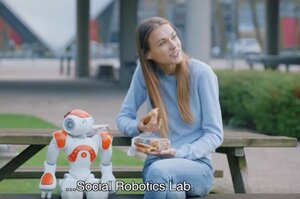Social Robotics Lab
Towards humans understanding robots that understand humans
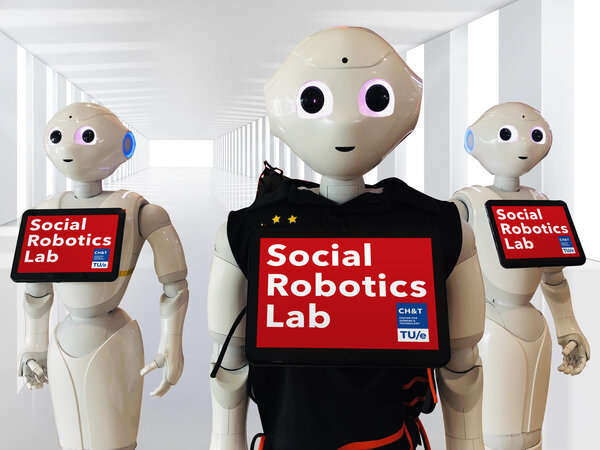
Responsible and socially intelligent robots
For society and business to embrace and successfully adopt these robots, it is necessary that these robots understand the way humans communicate, read their intentions and even form social relationships. The research of the Social Robotics Lab aims to create responsible and socially intelligent robots that can be adopted in a wide variety of human environments.
In its most basic form an autonomous robot simply circumnavigates people with sufficient clearance. However, treating people as objects with a given size and position is not enough for successful interaction with people. For one, a robot must respect social rules for keeping proper distance and use the proper direction of approach. What is proper is elusive, because it depends on the task of the robot, the state of the user, and environmental context. For example, an autonomous car should stop for a pedestrian who wants to cross the street at a zebra crossing. This means that the vehicle should recognize the pedestrian’s intent to cross the street. Similarly, a cleaning robot should be able to distinguish between people who are paying attention to it and those who do not. Thus the robot’s proper course of action depends on the intentions of people and their awareness of the situation. This also works the other way around. If people understand the robot’s intentions, they too can take a proper course of action. Ideally the robot understands social conventions and incorporates them in its own behavior planning. To this end, the robot must communicate its own intentions and recognize people’s intentions. The question is how to do this so that people understand that the robot understands them.
Crucial gap
Designing assistive technology is crucial for the future in which we have to deal with many challenges e.g. a growing ageing population, rising health costs, and shortages in medical and special-needs care. In this context, it is clear that recent developments in robotics promise an extremely attractive solution. A crucial gap that still needs to be bridged is that they must ultimately be accepted by humans in the human social sphere. An essential factor playing a role in robot acceptance is the ability of robots to react appropriately to human social signals and to follow norms of human behavior. Numerous studies have investigated introducing robots to people’s daily lives, healthcare, elderly care, and education, and several studies are part of our Social Robotics lab – behavioral training of children with ASD, robots in (special education, robots as persuaders, robots for elderly with dementia and persons with visual impairments and intellectual disabilities.
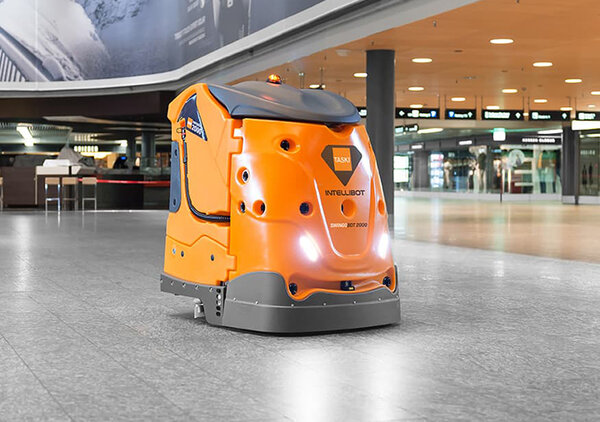
In its most simple form an autonomous robot simply circumnavigates people with sufficient clearance. However, treating people as objects with a given size and position is not enough for successful interaction with people. For one, a robot must respect social rules for keeping proper distance and using the proper direction of approach. What is proper, however, is elusive, because it depends on the task of the robot, the state of user, and environmental context. For example, an autonomous car should stop for a pedestrian who wants to cross the street at a zebra crossing. This means that the vehicle should recognize the pedestrian’s intent to cross the street. Similarly, when a cleaning robot that needs to clean a public area should be able to distinguish between people who are paying attention to it and those who do not. So again the robot’s proper course of action depends on the intentions of people and their awareness of the situation. Ideally, the robots understand social conventions and incorporate them in its own behavior planning. This works both ways. If people understand the robot’s intentions, they too can take a proper course of action. To this end, the robot must communicate its own intentions and recognize people’s intentions. The question is how to do this so that people understand that the robot understands them.
Research results
Robots working in environments with people have to operate in in a constantly changing environment. This requires the robots to become more flexible by understanding human behavior. Together with industrial partners we conduct research to enable robots with socially aware navigation, intention recognition and human-robot interaction. In the FAST (new Frontiers in Autonomous Systems Technology) new insights are being developed for better human-robot interaction. More information on FAST
In the context of the European FP7 KSERA our lab developed a socially assistive robot to help elderly people. Target groups of elderly have been persons with Chronic Obstructive Pulmonary Disease (COPD), with their daily activities and care needs, and provides the means for effective self-management of their disease. More information ons KSERA
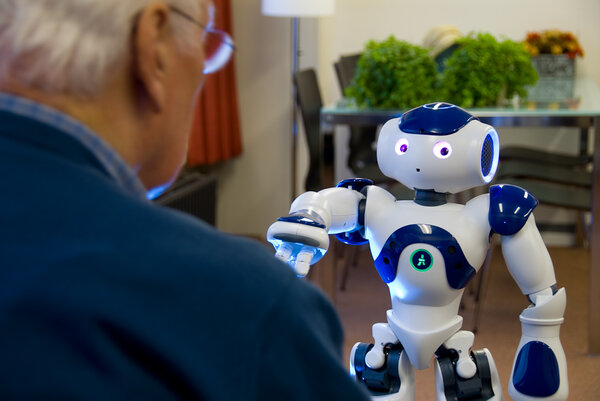
Persons with dementia have been provided with social robots to increase their engagement in activities and thus to keep them alert and engaged to delay the decease-related deterioration and increase the quality of their life (Engage-dem, part of EU Interactive Cognitive Environments project and Closer to nature projects, funded by CSA). Persons with visual impairments and intellectual disabilities has been trained to cope with worrying behavior, in the ZonMW project “Robot BART stopt het ‘piekeren’”.
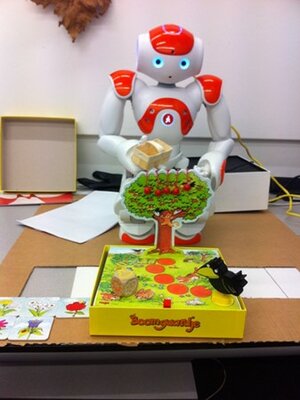
Also we developed robots to assist in the social training of children with autism (ZonMWPicasso and Wikitherapist projects ). The first results of clinical study indicate that the use of robotics in may be an effective treatment component in diminishing ASD-related symptoms and improving general clinical functioning in young children with ASD.
Last but not least, we have developed robots for education and persuasion as a part of the EU Erasmus mundus ICE project, and CSA funding scheme.
The Social Robotics Lab is part of the Center for Humans and Technology and designed for letting people interact with social robots in a mimicked home environment.
In our lab researchers from different fields cooperate thus creating multidisciplinary innovations.
External partners
Cooperation with external partners is welcomed. Our Social Robotics researchers have cooperated with various industrial partners such as Lely Industries, Vanderlande Industries, ExRobotics (ImProvia), Diversey and Rademaker. Those interested should contact Raymond Cuijpers. Our clinical partners are Karakter Nijmegen, dr. Leon Kannerhuis, and Bartiméus knowledge center.
In our lab researchers from different fields cooperate thus creating multidisciplinary innovations.
Contact
The Social Robotics Lab is lead by Emilia Barakova and Raymond Cuijpers.

Emilia Barakova:
“Our lab enables us to further strengthen our social robotics research. It will also lead to more depth and complementary aspects of this research. Together we will work towards the development of moral and ethical artificial "agents" that will support people with applications in various domains such as healthcare, education and industry.”

Raymond Cuijpers:
“The rapid developments in robotics and artificial intelligence will produce much more capable robots, but their social intelligence, which is needed to interact with people, is often lacking. Our Social Robotics Lab offers researchers the opportunity to combine their efforts and focus their research on artificial social intelligence."
